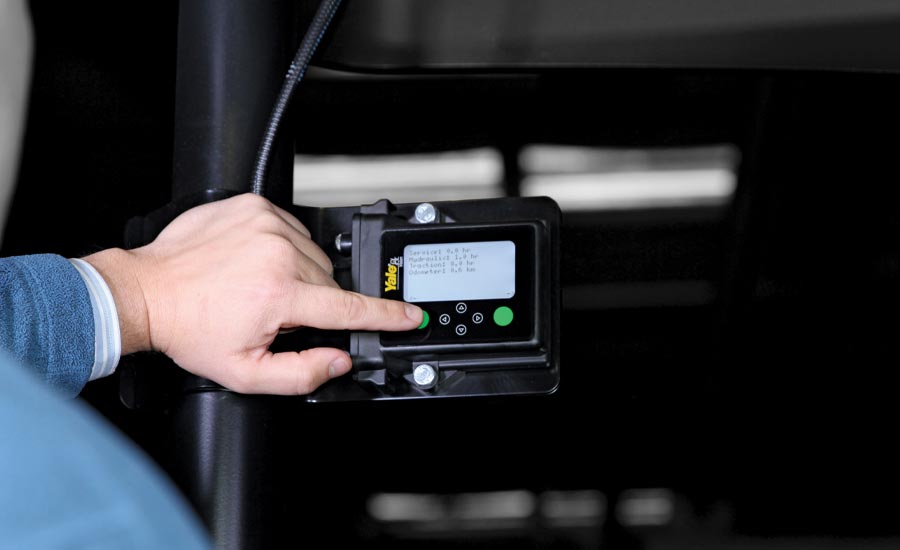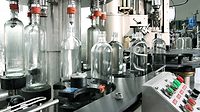Distribution
Telematics help distribution meet challenges head-on
AI, machine vision help optimize beverage operations

Image courtesy of Yale Lift Truck Technologies
As of 2023, singer Robyn Rihanna Fenty, widely known as Rihanna, is considered to be the wealthiest female musician with an estimated net worth of $1.4 billion. Aside from her music, Rihanna, also known for her involvement in the fashion industry, and as the founder of the fashion house Fenty under LVMH, is quoted for once having said: “Waking up in the morning and deciding to get dressed is probably the longest part of my day. I have too many clothes, I have too many options.”
Having too many options can create challenges for not just one’s wardrobe, but any industry. Within beverage operations, experts note that with increasing SKUs, telematics systems are helping to not only manage the dispatch of many different products in the warehouse, but also boost distribution efficiency — minimizing expenses, while helping operators meet throughput targets.
“Beverage operations are seeing 2-8% more new product introductions than the next leading category, meaning more SKUs to process, store and distribute,” says Mark Koffarnus, director of major accounts at Yale Lift Truck Technologies, Greenville, N.C. “Same-day delivery is also becoming an expectation, making speed and agility a priority for operations, all while keeping costs down.”
Susan Comfort, senior manager of technology solutions marketing, and John Rosenberger, director of iWAREHOUSE GATEWAY and global telematics at Greene, N.Y.-based The Raymond Corp., echo similar sentiments, noting that increased SKUs has led to more piece and case picking, that require different handling equipment in operations.
“There is now a wider variety of products available on store shelves compared to the past, when you only had three or four selections. Because of the variety, smaller packages are being shipped in smaller quantities,” they explain. “Managing the velocity of these many different products in the warehouse and in the last mile has become crucial to get them to the store on time.”
Furthermore, with the increasing number of SKUs, the rise of logistics solutions have made it necessary to manage telematics to minimize expenses and provide insight, Comfort and Rosenberger note.
“Online purchasing has become increasingly popular, which has led to the rise of logistics solutions such as 3PLs and 4PLs, who can take over parts or the entire distribution network,” they explain.
Addressing labor concerns
Although beverage operations have long adopted and frequently use automation, with ongoing labor issues affecting beverage operations, experts highlight how telematics now are being utilized to supplement and augment labor.
Yale’s Koffarnus points to today’s warehouses continually facing a tough outlook with persistent labor challenges threatening productivity and risking safety incidents.
“Nearly half (47%) of those in the beverage supply chain find the lack of skilled workers to be their greatest challenge,” he says.
Meanwhile, as warehouses face constant pressure to do more — fulfilling greater volumes of orders at an increasingly fast pace — meeting such intense throughput targets depends on lift truck operators performing at their best — day in and day out, Koffarnus says.
“As operations work to maximize productivity at every turn, maintaining a strict focus on lift truck best practices and facility-specific traffic rules can be challenging,” he explains. “In the event errors do happen, businesses risk compromising equipment, facility infrastructure and even the safety of personnel, while accumulating financial costs and unplanned downtime they simply cannot afford.”
Moreover, noting that OSHA estimates that nearly 100,000 injuries involving forklifts occur annually, Koffarnus points out that, warehouses need tools that support safety efforts, especially as employee turnover and inexperienced operators exacerbate these challenges.

Image courtesy of Yale Lift Truck Technologies
“Integrating technology like telematics or operator assist solutions can help facilities move their entire business forward — whether that’s reducing labor costs, boosting productivity or meeting other goals,” he says. “For instance, Yale Vision telemetry provides customers with insights and controls to improve operator behavior, control access to equipment, confirm pre-shift checklist completion, and monitor equipment and operator utilization.”
Echoing similar sentiments, The Raymond Corp.’s Comfort and Rosenberger, note that telematics systems also allow companies to dig deep into their operations and better understand how to utilize assets.
“The fast-paced nature of the beverage industry makes it tough to keep track of everything from equipment to operators, and telematics systems help to provide that visibility,” they explain. “Telematics systems can also aid in improving the effectiveness of operator training by identifying gaps and areas where improvement is needed.”
Mayank Sharma, head of global project management at Teletrac Navman, Irvine, Calif., notes that by using both IOT sensor technology and cameras, beverage operations can detect harsh driving behaviors — such as acceleration, braking and swerving.
“Using this data, fleet managers can schedule coaching conversations with drivers with actual specific instances and data points to help them follow safety protocols,” he says.
Yale’s Koffarnus points to telematics systems like Yale Vision that make critical maintenance data accessible, while also providing alerts and fault codes related to hazardous driving behaviors.
“Another feature available with some systems is load sensing,” Koffarnus says. “Depending on the system and truck configuration, if onboard sensors detect a load beyond the truck’s rated capacity, the telemetry system can respond in a variety of ways, including alerting the operator via the display, notifying supervisors of the event, and setting hydraulic and traction restrictions.”
Machine visuals, AI optimize operations
As telematics suppliers are utilizing solutions such as machine vision and artificial intelligence (AI) in their latest innovations, experts note that these technologies not only help improve operating best practices, but also work toward optimizing beverage operations as a whole.
The Raymond Corp.’s Comfort and Rosenberger, note that machine vision technologies and light detection and ranging (LIDAR) are being used together to provide a good work environment for operators and aid in the reduction of incidents.
“AI comes in to integrate these technologies to ensure they have enough information to take action through a process called sensor fusion,” they explain. “The use of machine vision and LIDAR can provide a more comprehensive view of the environment, while AI can analyze the data and provide insights to optimize operations.”
Teletrac’s Sharma points to the company’s camera systems that feature machine learning with AI built into the algorithms.
“Our camera systems have ML/AI built into the algorithms to detect behavior and actions such as talking on the phone, smoking, or eating while driving, which fleet managers typically want their drivers to stop or improve,” he says. “Further, algorithms can then detect and only show the relevant clips of unwarranted behavior to the fleet managers.
“A different use case where AI and machine learning is used extensively is where we can use AI technology to start to predict vehicle downtime or parts failure,” Sharma continues. “This can allow fleet operators to perform preventative maintenance and reduce downtime costs significantly.”
Yale’s Koffarnus points to telemetry systems such as the Yale Vision impact camera, a lift truck telemetry accessory that captures clear video footage of the events before and after an impact.
“The impact camera provides warehouse managers with greater visibility to help improve safety, increase efficiency and reduce costs,” Koffarnus says. “The camera syncs with the impact detection system so when a critical impact occurs, video footage of three minutes before and after is automatically saved.
“The dual cameras provide large panoramic views in both the front and rear, conveniently powering on and off automatically with the lift truck,” he continues. “Full HD video during playback captures fast-moving content, even in harsh and low light environments, to help validate impacts and identify product damage and inventory shrinkage issues.”
Key benefits, return on investment
As telematics systems offer a broad range of insights into warehouse and distribution operations, experts highlight the key benefits of utilizing these systems.
“By providing a thorough look into a fleet’s day-to-day operations, telemetry can help warehouses schedule and track preventative maintenance, better understand total cost of operation, and know truck locations within the site,” Yale’s Koffarnus says. “Telemetry systems like Yale Vision offer a broad range of insights about lift truck usage and performance, some of which can be leveraged as effective tools for data-driven performance tracking to help operations cultivate employee trust, clear expectations, and [provide] a framework for success.
“By assigning utilization and impact data to individual operators, they add an extra layer of accountability for ineffective operators, while incentivizing high-performing employees, yielding more informed labor management decisions,” he continues. “Employees can feel more confident that their performance-based incentives are just that — performance-based— not swayed by individual opinions or perceived favoritism.”
The Raymond Corp.’s Comfort and Rosenberger note that telematics systems can be expanded-on to include operator assist technologies that further improve efficiency and security.
“Technologies like pick-to-pallet or pick-to-light are extremely helpful when operators are batch picking multiple pallet floor level orders,” they explain. “The light shows the operator which pallet to place the item on to reduce pick errors when batch picking. Raymond offers this technology through the patented Pick2Pallet LED light system, a pick to light system designed to help reduce picking errors by using LED technology to visually reinforce product placement for order fulfillment in batch picking applications.”
Further, as far as return on investment (ROI) goes, Comfort and Rosenberger note that for a telematics system, it generally takes between 12 to 15 months to see returns.
“However, the actual ROI may vary depending on the specific system being implemented and the size of the facility where it is being used,” they note. “A single decision to implement a telematics system can lead to significant positive changes in terms of efficiency and asset management.”
Teletrac’s Sharma points to savings that come by reducing idling or lowering fuel burn by consistent driving and lowering maintenance down time for the vehicles.
“Second, telematics can reduce potential for accidents, but that is harder to quantify,” Sharma says. “But, by reducing accident probability — even by 10% — for a fleet through enforcing safety protocols and driver coaching can pay for a telematics system multifold.”
Looking for a reprint of this article?
From high-res PDFs to custom plaques, order your copy today!






